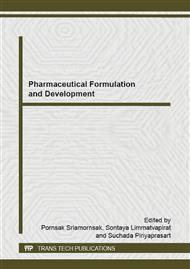p.99
p.103
p.107
p.111
p.115
p.119
p.124
p.128
p.133
Preparation and Characterization of Hydrocolloid Stabilized Silver Nanoparticles
Abstract:
Silver nanoparticles (AgNPs) are of considerable interest for medical application due to their antimicrobial activity. However, only a limited number of natural polymers have been reported as colloidal stabilizers for AgNPs. This study aimed to synthesize AgNPs using hydrocolloids, alginate and carrageenan, as stabilizers. Hydrocolloid-capped AgNPs were synthesized by two methods: M1, a reductive sodium borohydride (NaBH4) method, and M2, a microwave assisted reduction method. The synthesized AgNPs were characterized for surface plasmon resonance (SPR), size, surface charge and morphology. From the results, AgNPs stabilized by alginate (al-AgNPs) and carrageenan (ca-AgNPs) were able to be synthesized by methods M1 and M2. The SPR absorption peak around 400 nm of AgNPs represented the formation of rather spherical particles. The AgNPs formed by method M1were narrower in size distribution than that of AgNPs formed by method M2. Laser doppler electrophoresis (LDE) showed negative surface charges of al-AgNPs and ca-AgNPs because the anionic hydrocolloid polymers consist of carboxylic acid (alginate) and sulfate (carrageenan). Conclusively, AgNPs can be successfully formed and stabilized by alginate and carrageenan. Hydrocolloid-capped AgNPs are stable due to the electrostatic repulsion and steric stabilization of such polymers.
Info:
Periodical:
Pages:
115-118
Citation:
Online since:
December 2014
Price:
Сopyright:
© 2015 Trans Tech Publications Ltd. All Rights Reserved
Share:
Citation:


